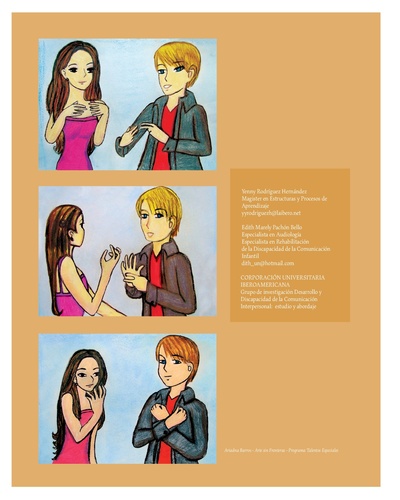Tendencias de la investigación en la lengua de señas
Contenido principal del artículo
Autores
Yenny Rodríguez Hernándezyyrodriguezh@laibero.net
Edith Marely Pachón Bello
dith_un@hotmail.com
Resumen
El objetivo de este artículo fue identificar las tendencias investigativas mundiales de los estudios de la Lengua de Señas entre el año 2000 y el 2011 (primer bimestre) a partir de la revisión de 20 revistas indexadas que se encuentran en las bases de datos electrónicas Scielo, Pubmed, y PROQUEST. Los artículos están escritos en diferentes lenguas como Español, Inglés y Portugués. Para este propósito cinco variables fueron registradas: a) el nombre de las revistas; b) la producción investigativa por año, c) el porcentaje de autores por artículo, d) los autores más destacados, y e) los temas trabajados. Los resultados muestran 196 artículos de investigación en términos de frecuencia y porcentajes. También hay siete temas: el 25,7% de estos artículos se refiere a las características de la lengua de señas; el 24,5% estudia la lengua de señas y la educación; el 22,7% se centra en las variaciones sociolingüísticas de la Lengua de Señas; el 7% se refiere a la comunicación bimodal; el 6% se centra en el proceso lecto-escrito; el 4% estudia el procesamiento psicolingüístico, y el 3% revisa las bases neurológicas de la lengua de señas. Teniendo en cuenta lo anterior, se determinan los siete temas expuestos como las tendencias investigativas en cuanto a la Lengua de Señas. Al finalizar hay algunas propuestas de investigación que pueden ser desarrolladas con el fin de apoyar la comprensión de esta lengua.
Palabras clave:
Detalles del artículo
Licencia
Aquellos autores/as que tengan publicaciones con esta revista, aceptan los términos siguientes:
- Los autores/as conservarán sus derechos de autor y garantizarán a la revista el derecho de primera publicación de su obra, el cuál estará simultáneamente sujeto a la Licencia de reconocimiento de Creative Commons que permite a terceros compartir la obra siempre que se indique su autor y su primera publicación esta revista.
- Los autores/as podrán adoptar otros acuerdos de licencia no exclusiva de distribución de la versión de la obra publicada (p. ej.: depositarla en un archivo telemático institucional o publicarla en un volumen monográfico) siempre que se indique la publicación inicial en esta revista.
- Se permite y recomienda a los autores/as difundir su obra a través de Internet (p. ej.: en archivos telemáticos institucionales o en su página web) antes y durante el proceso de envío, lo cual puede producir intercambios interesantes y aumentar las citas de la obra publicada. (Véase El efecto del acceso abierto).
Los autores que publican en la revista se acogen al código de licencia de Creative Commons Atribución 4.0 Internacional (CC BY 4.0)




Referencias
Emmorey K. Language. Cognition and brain. Lawrence Erlbaum Associates, Publishers. Mahwah, New Jersey London; 2002. pp 21-23.
Svartholm K. Bilingual Education for Deaf Children in Sweden. International Journal of Bilingual Education and Bilingualism. 2010; 13 (2) : 159-174.
Reffei H, Locker M. Motives and Outcomes of New Zealand Sign Language Legislation: A Comparative Study between New Zealand and Finland. Current Issues in Language Planning. 2009; 10 (3) : 272 -292.
Quadros R. Políticas lingüísticas e educação de surdos em Santa Catarina: espaço de negociações. Cad. CEDES. 2006; 6 (29) : 141 -161.
Burnside K. American Sign Languague: An Innovative Middle School Program. Learning Languages. 2009; 15 (1) 40 – 41.
Emmorey K. Language, cognition and brain. Lawrence Erlbaum Associates, Publishers. Mahwah, New Jersey London. 2002. 21-23
Stokoe W, Volterra. Sign Language Research. Silver Spring: Linstock. 1983. 266 - 273.
Armstrong D. Gesture and the Nature of Semantic Phonology. En: Sign Language Studies. 2008; 14 (3) : 410 – 416.
Carty B, Macready S, Sayers E. A Grave and Gracious Woman: Deaf People and Signed Languages in Colonial New England. Sign Language Studies. 2009; 52 (2) : 287 – 323.
Dachkovsky S, Sandler W. Visual Intonation in the Prosody of a Sign Language. Language and speech. 2009; 52 (2/3) : 287–314.
Thompson R, Vinson D, Vigliocco G. The link between form and meaning in British Sign Language: effects of iconicity for phonological decisions. Journal of Experimental Psychology Learning, Memory and Cognition. 2010; 34 (4) : 1017-1027.
Bosworth R, Emmorey K. Efeccts of iconicity and semantic relatedness on lexical access in American Sign Language. Journal of Experimental Psychology. 2010; 36 (6) : 1573 – 1581.
Johnson R, Scott K. Toward a Phonetic Representation of Signs, I: Sequentiality and Contrast. Sign Language Studies. 2010; 9 (3) : 241 - 274.
Slobin D. Breaking the Molds: Signed Languages and the Nature of Human Language. Sign Language Studies. 2008; 3 (4) : 114 – 130.
Johnston T, Napier J. Medical Signbank: Bringing Deaf People and Linguists Together in the Process of Language Development. Sign Language Studies. 2010; 9 (2) : 258 – 275.
Ten Holt G, Van Doorn A.J, de Ridder H, Reinders J.M. Which Fragments of a Sign Enable its Recognition?. Sign Language Studies. 2009; 2 (3) : 211 – 239.
Bailes C, Erting L, Thumann-Prezioso C; Erting C. Language and Literacy Acquisition Through Parental Mediation in American Sign Language. Sign Language Studies. 2009; 109 (1) : 417 – 456.
Winn S. Sign Language Acquisition and Use by Single-Generation Deaf Adults in Australia Who Attended Specific Educational Settings for deaf and hand of hearing children. sign language studies. 2007; 1(2):59-71.
Pizer G, Walters K, Meier R. Bringing Up Baby with Baby Signs: Language Ideologies and Socialization in Hearing Families. Sign Language Studies. 2007; 5 (2) : 387 – 430.
Lillo – Martin D, De Quadros R. Acquisition of the syntax-discourse interface: The expression of point of view. Lingua International Review of General Linguistics. 2011; 121(4) : 623 – 636.
Sayers E, Gates E. Lydia Huntley Sigourney and the Beginnings of American Deaf Education in Hartford: It Takes a Village. Sign Language Studies. 2008; 4 (2) : 369 – 411.
Thoryk R. A Call for Improvement: The Need for Research-Based Materials in American Sign Language Education. Sign Language Studies. 2010; 2 (3) : 100 – 120.
Snoddon K. Technology as a Learning Tool for ASL Literacy. Sign Language Studies. 2010; 3 (3) : 197 – 213.
Thoutenhoofd E. Acting with Attainment Technologies in Deaf Education: Reinventing Monitoring as an Intervention Collaboratory. Sign Language Studies. 2010; 2 (3) : 214 – 230.
Van Gils G, Van den Bogaerde B, De Lange R. The Use of Modern Information and Communication Systems and Technology and Experienced Stress at Work in Mixed Deaf-Hearing Teams. Sign Language Studies. 2010; 1 (4) : 231 – 257.
Fuentes M, Massone M, Fernández-Viader A, Pulgarín M. NumeralIncorporating Roots in Numeral Systems: A Comparative Analysis of Two Sign Languages. Sign language Studies. 2010; 12 (1) : 55 – 75.
McPherson J. A Fair Chance in the Race of Life: Thoughts on the 150th Anniversary of the Founding of the Columbia Institution. Sign Language Studies. 2008; 8 (1) : 33 – 44.
Friedner M. Biopower, Biosociality, and Community Formation: How Biopower is Constitutive of the Deaf Community. Sign Language Studies. 2010; 12 (1) : 336 – 347.
Caicedo M. Capítulo 1 Introducción a la Sociolingüística. Cali: Universidad del Valle; 1997.
Bonvillian J, Ingram V, McCleary B. Observations on the Use of Manual Signs and Gestures in the Communicative Interactions between Native Americans and Spanish Explorers of North America: The Accounts of Bernal Díaz del Castillo and Álvar Núñez Cabeza de Vaca . Sign Language Studies. 2009; 55 (1) : 132 – 165.
Tree E. Meemul Tziij: An Indigenous Sign Language Complex of Mesoamerica. Sign Language Studies. 2009; 1 (4) : 324 – 366.
Duarte K. The Mechanics of Fingerspelling: Analyzing Ethiopian Sign Language. Sign Language Studies. 2010; 11 (3) : 5 – 21.
Day L, Sutton S. British Sign Name Customs. Sign Language Studies. 2010; 11 (2) : 22 – 54.
Parks E, Parks J. Treatment of Signed Languages in Deaf History Texts. Sign Language Studies. 2010; 5 (4) : 72 – 93.
Quinn G. Schoolization: An Account of the Origins of Regional Variation in British Sign Language. Sign Language Studies. 2010; 104 (4) : 476 – 501.
Aldersson R, McEntee-Atalianis L. A Lexical Comparison of Signs from Icelandic and Danish Sign Languages. Sign Language Studies. 2008; 109 (2-3) : 45 – 87.
Fraser B. Deaf Cultural Production in Twentieth-Century Madrid. Sign Language Studies. 2007; 12 (1) : 431 – 457.
Kovelman I, Shalinsky M, White K, Schmitt Sh. & colaboradores. Dual Language Use in Sign-Speech Bimodal Bilinguals: FNIRS BrainImaging Evidence.Brain and Language.2009; 9 (1) : 112 – 123.
Tevenal S, Villanueva M. Are You Getting the Message?: The Effects of SimCom on the Message Received by Deaf, Hard of Hearing, and Hearing Students. Sign Language Studies. 2009; 2 (3) : 266 – 286.
Morford J, Wilkinson E, Villwock A, Pinar P, Kroll J. Effects of Language Experience on the Perception of American Sign Language. Cognition. 2011; 7 (3) : 747 – 762.
Quartararo A. The Poetry of a Minority Community: The Deaf Poet Pierre Pélissier and the Formation of a Deaf Identity in the 1850s. Sign Language Studies. 2008; 5 (1) : 241 – 263.
Esmail J. The Power of Deaf Poetry: The Exhibition of Literacy and the nineteenth-Century Sign Language Debates. Sign Language Studies. 2008; 11 (4) : 348 – 368.
Monford J, Grieve-Smith A, MacFarlane J, Staley J y colaboradores. When Deaf Signers Read English: Do Written Words Activate Their Sign Translations?. Sign Language Studies. 2008; 6 (4) : 286 – 292.
Baus C, Gutierrez-Sigut E, Quer J, Carreiras M. Lexical access in Catalan Signed Language (LSC) production. Cognition. 2008; 118 (2) : 856 – 865.
Courtin C, Helber Py, Peit L, Vigneau L, y otros. The Neural Correlates of Highly Iconic Structures and Topographic Discourse in French Sign Language as Observed in Six Hearing Native Signers. Brain and Language. 2010; 23 (3) : 180 – 192.
Mayberry R, Chen J, Klein D. Age of acquisition effects on the functional organization of language in the adult brain. Brain and Language. 2011; in press.
Capek, Woll, MacSweeney y colaboradores. Superior Temporal Activation as a Function of Linguistic Knowledge: Insights from Deaf Native Signers Who Speechread. Brain and Language. 2010; 52 (2-3) : 129 – 134.
Zhiguo H, Wenjing W, Hongyan L & colaboradores. Brain Activations Associated with Sign Production Using Word and Picture Inputs in Deaf Signers. Brain and Language. 2011; 9 (4) : 64 – 70.
Emmorey K, Grabowski T, McCullough S, Damasio H & colaboradores. Motor-Iconicity of Sign Language Does Not Alter the Neural Systems Underlying Tool and Action Naming. Brain and Language. 2004; 11 (3) : 27 – 37.


 PDF
PDF










